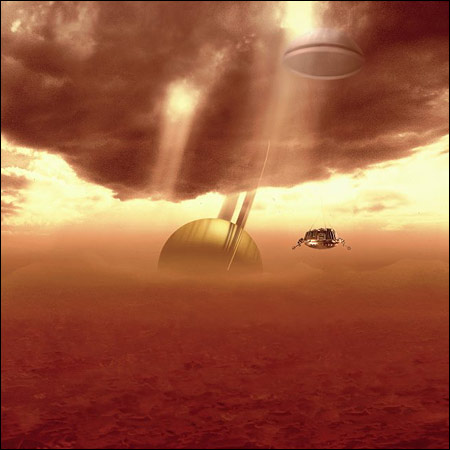The Huygens spacecraft will enter Titan's atmosphere at 09:07 GMT (11:07 Israel time) and will land shortly after. Then it will also transmit a weak signal towards Earth and towards its mother spacecraft, Cassini.

The Huygens spacecraft will enter Titan's atmosphere at 09:07 GMT (11:07 Israel time) and will land shortly after. Then it will also transmit a weak signal towards Earth and towards its mother spacecraft, Cassini.
Ground controllers may receive the first signal from Huggins at the earliest at 10:30 a.m. GMT from sensitive radio telescopes listening to the frequency on which the robotic spacecraft is transmitting.
"This will give us an indication that the spacecraft is functioning well and that it has penetrated Titan's atmosphere," says Dr. Jean-Pierre Leverton, the lead scientist on the Huygens project, to journalists at the European Control Center in Darmstadt, Germany.
and to the full schedule as published by the European Space Agency. Times are according to Greenwich Mean Time.
05:51 GMT - A timer activated an electrical system that woke up the system that had been in "sleep" mode to save energy. From this time the spacecraft was supposed to start broadcasting.
10:13 Huygens will reach the entrance to the atmosphere - defined as a height of 1270 km above the surface of the moon Titan - the moment of penetration is of course a critical moment.
10:17 The flight parachute will open and slow the speed of the spacecraft to 400 meters per second at a height of about 180 km above the surface.
The flight parachute is the smallest of the spacecraft's parachutes - it is only 2.6 meters in diameter and its purpose is to pull the spacecraft's back cover that protects Huygens from the heat of friction upon entering the atmosphere.
2.5 seconds after the flight chute opens, the back cover will be released and the small chute will separate from the spacecraft. The main parachute - which is 8.3 meters in diameter will deploy.
10:18 Huygens will begin transmitting to Cassini and release the front shield at an altitude of 160 kilometers above the surface.
42 seconds later, small hatches will be opened to allow several instruments - the gas chromatograph, the mass spectrometer and the aerosol collection device - to be exposed to the atmosphere.
The descent radiometer will capture the first panoramic image and continue to capture and provide spectral data throughout the descent. The scientific package that will operate on the surface will also be turned on and measure the properties of the atmosphere.
10:32 - The main chute will separate and open a smaller chute, also defined as an anchor, which is 3 meters in diameter. At this height in the atmosphere, about 125 kilometers. This chute will allow the spacecraft to descend at the right rate to collect the maximum possible data.
1049: All actions so far will be performed automatically. At an altitude of 60 kilometers, the spacecraft will be able to find its own altitude using two radar-based altimeters, which will include measuring the exact distance to the surface. The spacecraft will constantly monitor the rotation rate and altitude and feed this data to the scientific instruments. As such the times from here on are approximate.
1157 – The gas chromatograph. The mass spectrograph will start by sampling the atmosphere. This is the last Huygens device to be fully operational. The full descent will last 137 minutes, plus or minus 15 minutes. During the descent, the spacecraft will continue to spin at a rate of one revolution per 20 revolutions and allow the camera and other instruments to see a panoramic image around the descending spacecraft.
12:30 close to the surface of the earth a light will be lit in the camera. The light is especially important to the spectral radiometer - part of an instrument used to determine the exact composition of Titan's surface.
12:34 Touching the surface. This time may change plus or minus 15 minutes depending on the effect of the atmosphere and winds on the Huygens parachutes. The spacecraft will reach the ground at a speed of 5-6 meters per second. Huygens may land on rocky or glacial terrain or in a sea made of ethane. In any case, the surface science suite is designed to collect every piece of information about the surface that can be diagnosed in the six minutes that Huygens is expected to survive after landing.
14:44 Cassini will stop collecting data from Huygens
Even if the spacecraft survives, it will simply sink beyond Titan's horizon as seen from Cassini and it will stop collecting data. Cassini will listen for signals from Huygens as long as there is even the faintest possibility that those signals can be detected. Once the Huygens landing site disappears below the horizon, there is no longer any chance of hearing signals. Huygens' work will come to an end.
15:14 - The first data will be transmitted to Earth. Cassini's main antenna, which will be pointed at Titan throughout the day, will be aimed at Earth and then the first batch of data will be transmitted.
Receiving data from Cassini is now a routine operation, but in the Huygens mission security mechanisms were added to ensure that no data sent from Huygens would be lost. In addition to the deep space network's permanent antennas used to listen to the transmissions of the spacecraft on distant missions, huge radio antennas around the world will also listen to Cassini as it transmits back copies of the Huygens data.
Yedan Saturn
For news at the BBC
Saturn in astrology
https://www.hayadan.org.il/BuildaGate4/general2/data_card.php?Cat=~~~1800882~~~251&SiteName=hayadan
